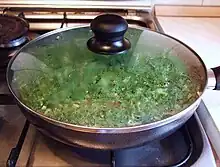Kuku (food)
Kuku or kookoo (Persian: کوکو) is an egg-based and often vegetarian Iranian dish made of whipped eggs folded in various ingredients. It is similar to the Italian frittata, the French quiche, or an open-faced omelette, but it typically has less egg than a frittata, and it cooks for a shorter amount of time, over a low heat, before turned over[1] or grilled briefly to set the top layer.[2] It is served either hot or cold as a starter, side dish or a main course, and is accompanied with bread and either yogurt or salad.[3] In parts of northern Iran, kuku might be used as a midday meal, and might be served with either plain cooked rice (kate) or bread.[4]
.jpg.webp) Kuku sabzi (herb kuku) topped with barberries and walnuts | |
| Type | Omelette |
|---|---|
| Course | Side dish, main course, or midday course |
| Place of origin | |
| Associated cuisine | Iranian cuisine |
| Main ingredients | Eggs |
| Variations | Herb kuku, potato kuku, eggplant kuku, roe kuku |
| Similar dishes | Frittata, Quiche, Eggah |
Cookbooks from Iran's Safavid and Qajar periods mention kuku.[5] Qajar documents introduce it as a side dish.[6] Herb kuku (kuku sabzi), which is the most popular type,[4] is served traditionally at Nowruz, the Iranian New Year's Day,[6][7] symbolizing a fresh start[8] and also at Easter,[9] which is celebrated by the Iranian Armenians and Iranian Georgians.
Cooking methods

The traditional preparation of kuku involves frying the ingredients in oil over a low heat and is accomplished with steaming in a closed space.[10] Baking is also a popular method nowadays. An extra thickness is given to the dish by adding yeast.[4] The ultimate result is a cake-like omelette that is usually served with bread, but it might rather be accompanied with rice, particularly in the northern Iranian province of Gilan, where the consumption of rice in general was traditionally preferred over bread.[4]
Variations
Kuku is made with various ingredients and in a variety of styles,[11] including herb kuku (kuku sabzi), potato kuku (kuku sibzamini), eggplant kuku (kuku-ye bādenjān, vereqā), roe kuku (ašbal kuku), and yogurt kuku (kuku-ye māst).[12][13]
Herb kuku
Herb kuku, or kuku sabzi in Persian, is the most common type of kuku.[4] It is made of eggs and herbs such as leeks and parsley. Garlic, which is especially popular in the northern regions of Iran, is also used as an ingredient.[14]
Potato kuku
Potato kuku, or kuku sibzamini in Persian,[15] which is almost identical to the Spanish omelette (potato tortilla),[6] is made of eggs, potatoes and other ingredients.
See also
- Frittata, a similar Italian dish
- Eggah, a similar Arab dish
- Egg bhurji
- Tunisian tajine, a similar Tunisian dish
- Shakshouka
- Iranian cuisine
- List of egg dishes
References
- Brown, Sarah (1984). Vegetarian Cookbook. HarperCollins. p. 127. ISBN 0-7225-2694-6.
- Riley, Gillian (1 November 2007). "Eggs". The Oxford Companion to Italian Food. Oxford University Press. p. 168.
- Batmanglij, Najmieh (24 October 2007). A Taste of Persia: An Introduction to Persian Cooking. I.B. Tauris. p. 49.
- Bromberger, Christian. "Gilān xxi. Cooking". Encyclopædia Iranica (online ed.). Retrieved 29 June 2019.
- Aʿlam, Hūšang (31 October 2011). "Coriander". Encyclopædia Iranica. Vol. VI. p. 273.
- Mahdavi, Shireen (2015). "Qajar dynasty xiv. Qajar Cuisine". Encyclopædia Iranica (online ed.). Retrieved 19 March 2015.
- Bazin, Marcel; Bromberger, Christian; Balland, Daniel; Bāzargān, Ṣoḡrā (15 December 1989). "Berenj "rice"". Encyclopædia Iranica. Vol. IV. pp. 147–163.
- "Kuku Sabzi - No Dairy Frittata with Fresh Herbs". Kitchen Starts. 2020-10-23. Retrieved 2021-03-30.
- Scattergood, Amy (13 April 2017). "Say 'kuku' three times fast, then make the terrific Persian herb and egg dish for Easter brunch". Los Angeles Times.
- Dupree, Nancy Hatch. "Cooking". Encyclopædia Iranica. Vol. VI. pp. 246–252. Retrieved 28 October 2011.
- Ramazani, Nesta (1997). "Persian Souffles (Kookoo)". Persian Cooking: A Table of Exotic Delights. Ibex. pp. 53–65. ISBN 0936347775.
- Ewan, Julia (24 January 2007). "Yogurt Kuku". The Washington Post.
- Aʿlam, Hūšang (15 December 1990). "Carrot". Encyclopædia Iranica. Vol. V. pp. 13–17.
- Elahi, Etrat (2 February 2012). "Garlic". Encyclopædia Iranica. Vol. X. p. 315.
- Khan, Yasmin (2016). The Saffron Tales: Recipes from the Persian Kitchen. Bloomsbury Publishing. p. 76. ISBN 1408868741.
- Ottolenghi, Yotam (1 January 2010). "Yotam Ottolenghi's aubergine kuku recipe". The Guardian.
- Ghanoonparvar, M.R. (1982). Persian Cuisine I: Traditional Foods. Lexington, Kentucky: Mazda Publishers.
- Aubaile-Sallenave, F.; Elāhī, ʿE. (19 August 2011). "Bādenjān". Encyclopædia Iranica. Vol. III. pp. 366–368.
- Aʿlam, Hūšang (15 December 1990). "Caviar". Encyclopædia Iranica. Vol. V. pp. 99–101.
External links
- Bashar, Laura. "Persian Herb Quiche | Kookoo Sabzi (Kuku Sabzi)". Family Spice. Archived from the original on 2014-10-19. Retrieved 2014-10-14.
- "Kookoo-e Sabzi". Iran Chamber Society.
- Batmanglij, Najmieh. "Cauliflower Kuku". Splendid Table.
- Baratzadeh, Emily. "Kuku Sabzi - No Dairy Frittata with Fresh Herbs" Kitchen Starts.